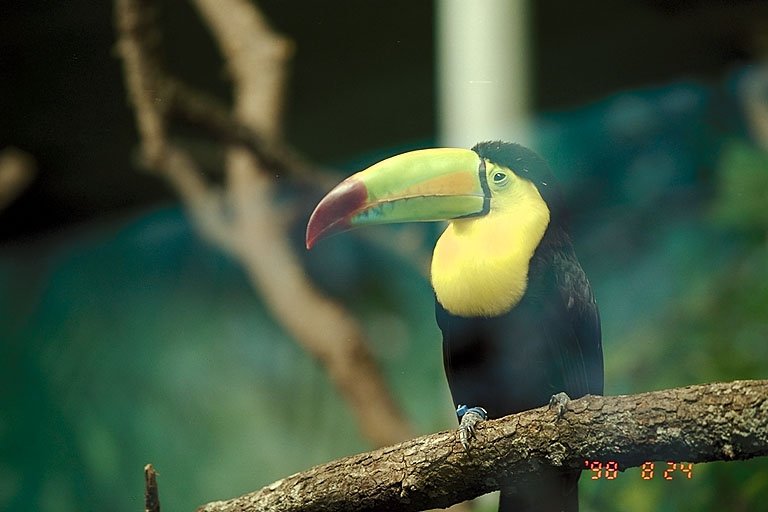THE KEEL-BILLED TOUCANBy Jenny Thurman
Photo courtesy of Brent A. Thale
(Photo taken at the Houston Zoo)Name: Keel-billed toucan Scientific name: Ramphastos Sulfuratus
Range: Central and South America
Habitat: Tropical and Subtropical Rainforests
Status: Threatened, but not endangered, dueto the destruction of its home the rainforest
Diet in the wild: Fruits (primarily berries),some insects, bird eggs, and tree frogs
Location in the zoo: Bird RowPhysical Description
The keel-billed toucan averages about 25 inches in length. Its bodyis covered with black plumage with red and white coverts under and on topof its tail. The toucan has green skin around its eyes and lore (the areabetween the eyes and the bill). The bird has a yellow face and throat andstands on two blue legs. Broad, heavy wings and a short tail force thebird to have a very laborious flight, flapping its wings hard in upwardand downward movements.
The most obvious characteristic of the toucan is its beak. A large rainbowcolored structure, the beak appears quite heavy and cumbersome, but isactually light because it is composed of the protein keratin. The beakis hollow with thin rods of bone to support it. It houses a feather liketongue which catches the animal's food and flicks it down its throat.
General Information
The keel-billed toucan is the national bird of Belize. A small, playfulbird, the toucan can often be found throwing berries at another bird orjousting with its beak with another toucan. These social practices fitin with the bird's very family-oriented nature. The toucan travels in flocksof six or more and lives holes in trees with several other toucans. Becausethe holes are relatively small, the toucans must tuck their tails and beaksunder them to conserve room when sleeping.
The toucans form strong bonds when paired off. The mother and fathertake turns sitting on their 2 to 4 glossy white eggs. The eggs hatch in16 to 20 days and spend the first 8 to 9 weeks in the nest as their beaksfully form.
Personal Observations
The toucan was a larger animal than I anticipated. I like many othershave always equated a toucan with the logo on the Fruit Loops Cereal box.I was surprised, however, to learn there are actually several types oftoucans that are distinguished primarily by their beak size and body coloring.Unfortunately I have no pictures for my site because during the time itwas created, the Fort Worth Zoo's toucan was feeling under the weather.
Current Research
Sources and Links:
Greer, Gilbert. Birds of Ambergri's Caye: 1996.www.ambergriscaye.com/bird/toucan.html
Keel-billed Toucan at Enchanted Learning
http://www.zoomwhales.com/subjects/birds/printouts/Toucancoloring.shtmlKeel-billed Toucan at Rio Dulce National Park
http://www.nps.gov/centralamerica/guatemala/toucan.shtmlGarcia, Derek. A Science Report on the Toucan: 1998.
www.rialto.k12.ca.us/school/garcia/derek.htm
(This source site is not currently on line.)Belize Zoo. Keel-Billed Toucan: 1998.
http://www.belizezoo.org/zoo/zoo/birds/tou/tou1.htmlVideo clip from the Belize Zoo, showing the use of the beak
http://www.belizezoo.org/zoo/zoo/birds/tou/tou3.htmlKeel-billed Toucan: Preservation Puzzles
http://stores.yahoo.com/wosi/214445.htmlPhoto courtesy of the Brent A. Thale
